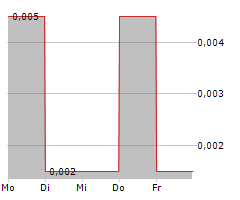Vancouver, British Columbia--(Newsfile Corp. - August 28, 2025) - Pacific Empire Minerals Corp. (TSXV: PEMC) ("Pacific Empire", "PEMC" or the "Company"), a British Columbia copper-gold explorer, is pleased to provide further details on priority drill targets for its 2025 diamond drill program at the Trident property, located in north-central British Columbia. The program will consist of five holes totaling approximately 2,500 metres, designed to test both known porphyry mineralization and new high-priority porphyry and breccia targets that, despite decades of exploration on the project, have never been drill tested.
Drill Plan Overview
- Total Program: 5 holes, ~500 metres each (2,500 metres)
- Targets: 1 porphyry confirmation hole at the historical A Zone, 2 porphyry discovery holes, 2 breccia discovery holes
Despite nearly 80 historical drill holes completed on the Trident property since the 1970s, this northern target area has never been tested. The primary reason is access: drill testing requires crossing a creek, which historically limited exploration. With PEMC's recently granted Multi-Year Area-Based Exploration Permit, this will be the first-ever drill test of these targets.
PEMC believes the 2025 program represents the most compelling test of the Trident property in its 50-year history of exploration. With strong geological, geochemical, and geophysical evidence converging at the porphyry target, combined with the newly permitted access to undrilled breccia targets, Pacific Empire is uniquely positioned to advance toward a potential gold-enriched copper porphyry discovery.
Brad Peters, President & CEO of Pacific Empire, commented: "For decades, a single creek has prevented companies from drilling the most compelling part of Trident. With our new permit in place, Pacific Empire intends to be the first to test this area. Every investor dreams of being there at the start of a discovery - and at Pacific Empire, that moment is now."
Drill Program Details
The first hole of the program will be drilled at the historic A Zone, where porphyry-style copper-gold mineralization was originally encountered by Falconbridge in the 1970s and confirmed by Solomon Resources in 2007. Historical drilling intersected mineralized porphyry dikes interpreted to dip north at approximately 70 degrees. Hole 1 is designed to follow these mineralized dikes to depth, with the goal of determining whether they are connected to a larger mineralized porphyry body at depth. This hole provides PEMC with a unique opportunity to directly build on historical drilling and answer one of the central geological questions at Trident.
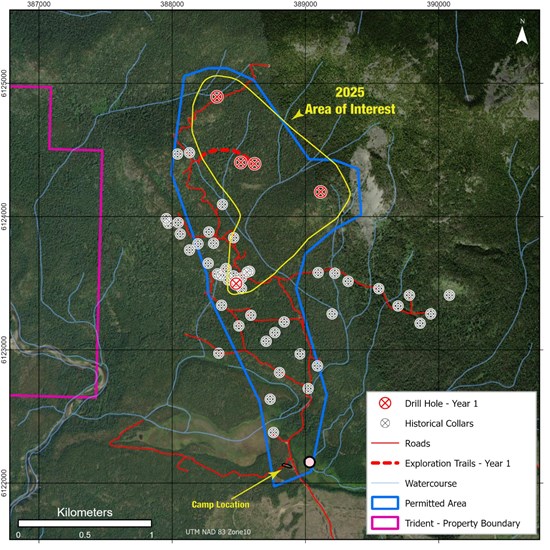
Figure 1 - Map showing Pacific Empire's fully permitted work area at Trident, including historical drill collars and the five planned 2025 drill holes. Nearly 80 historical holes have been completed south of the creek, yet the newly permitted northern area - long considered the most prospective ground - has never been drilled. With access, camp, and trails now established, Pacific Empire is positioned to be the first company to test these compelling porphyry and breccia targets.
To view an enhanced version of this graphic, please visit:
https://images.newsfilecorp.com/files/5412/264265_5770e0d7a45c5991_001full.jpg
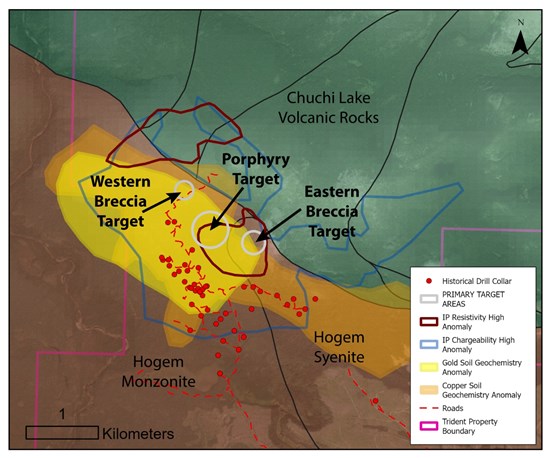
Figure 2 - Compilation map of the Trident property showing multiple independent datasets converging on a major discovery opportunity. A large porphyry target is outlined by copper and gold soil anomalies, resistivity and chargeability features, and favorable intrusive-volcanic contacts. Flanking this centre, conductivity highs define undrilled breccia targets supported by strong copper geochemistry. Together, the data outline a system-scale copper-gold target that has never been tested.
To view an enhanced version of this graphic, please visit:
https://images.newsfilecorp.com/files/5412/264265_5770e0d7a45c5991_002full.jpg
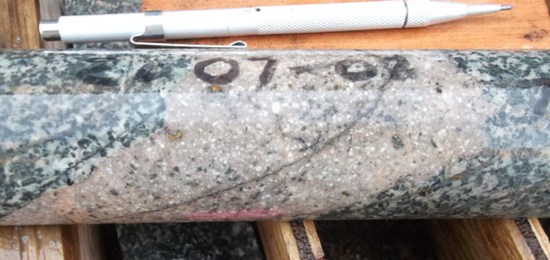
Figure 3 - Hornblende feldspar porphyry dike intersected in 2007 diamond drilling at Trident. The key question remains - where is the rest of the system?
To view an enhanced version of this graphic, please visit:
https://images.newsfilecorp.com/files/5412/264265_5770e0d7a45c5991_003full.jpg
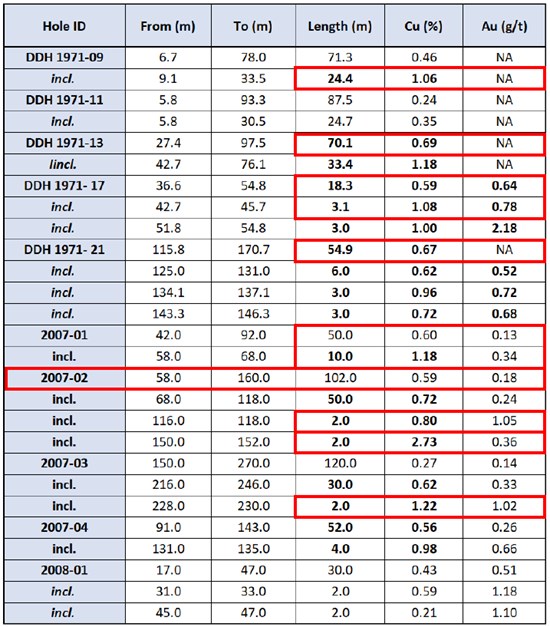
Figure 4 - Historical drilling at Trident has already delivered compelling copper-gold results, including 70 m of 0.69% Cu and 102 m of 0.59% Cu. Importantly, several intervals returned elevated gold grades, such as 3.0 m of 1.00% Cu with 2.18 g/t Au and 2.0 m of 1.22% Cu with 1.02 g/t Au. These results, consistently linked to hornblende feldspar porphyry dikes, highlight both the copper and gold potential of the system, with gold grades locally exceeding 2 g/t.
To view an enhanced version of this graphic, please visit:
https://images.newsfilecorp.com/files/5412/264265_5770e0d7a45c5991_004full.jpg
The next two holes, Holes 2 and 3, will focus on the primary porphyry target area, located immediately north of the A Zone. This target represents the most compelling discovery opportunity on the property. Several lines of evidence converge here: copper and gold soil anomalies appear to source from this area, while a DIGHEM airborne mag-EM survey flown by Solomon Resources in 2006 identified a coincident resistivity signature. In 2014, a PEMC/OZ Minerals IP survey outlined a large, strong chargeability anomaly, and most recently, a 2024 Mobile Magnetotelluric (MT) survey identified a resistivity high extending vertically to depth. Importantly, the MT signature is strikingly similar to that at Centerra's nearby Mt. Milligan copper-gold mine, highlighting the scale of the opportunity and underscoring Trident's potential to host a deposit of district significance.
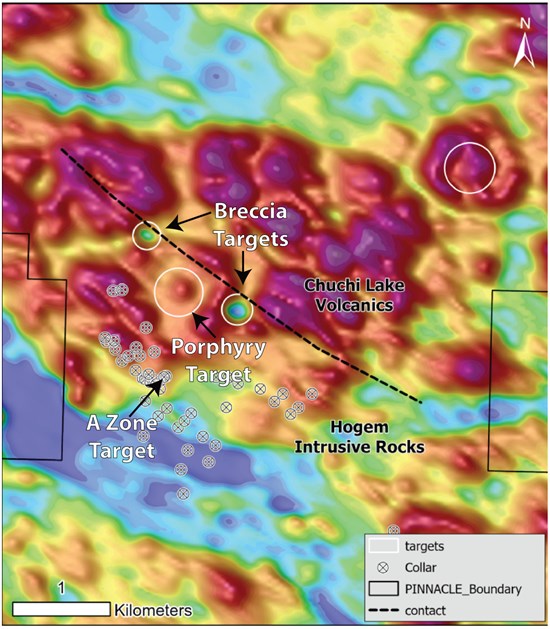
Figure 5 - The 2006 DIGHEM airborne resistivity survey (56,000 Hz) outlines a classic porphyry-style alteration pattern at Trident's central target: a slightly resistive core surrounded by a more conductive perimeter. This geophysical signature is consistent with a potassic-altered porphyry centre ringed by more conductive phyllic alteration. Importantly, this central feature coincides with strong copper and gold soil geochemistry and the contact between volcanic and intrusive rocks - a geological setting typical of major porphyry copper-gold deposits. Flanking this porphyry centre, conductivity highs to the east and west highlight potential breccia targets supported by both geophysics and geochemistry.
To view an enhanced version of this graphic, please visit:
https://images.newsfilecorp.com/files/5412/264265_5770e0d7a45c5991_005full.jpg
Geologically, this porphyry target sits directly at the contact between volcanic rocks of the Chuchi Lake Formation and intrusive rocks of the Hogem Plutonic Suite. Contacts between volcanic and intrusive rocks often act as "plumbing systems" that focus the flow of mineralizing fluids. This setting is a key control for many of British Columbia's most significant porphyry copper-gold deposits. The convergence of geochemistry, multiple geophysical datasets, and favorable geology makes Holes 2 and 3 a critical test of Trident's porphyry potential.
Hole 4 will target an eastern breccia zone, located immediately east of the porphyry target. This area is characterized by a conductivity high feature and is supported by strong surface geochemistry. Historical float samples returned very high copper and gold values, including one sample containing exceptionally high barite, copper, zinc, gold, and silver. The presence of these metals in combination is highly suggestive of a mineralized hydrothermal breccia system, which can host high-grade zones adjacent to porphyry systems. Drilling Hole 4 will provide the first subsurface test of this anomaly.
Hole 5 will target a western breccia zone, also defined by a conductivity feature and coincident with significant copper-in-soil anomalies. Despite its favorable characteristics, this target has never been drilled, in large part due to historical access limitations. With the potential for copper-rich breccia mineralization in close proximity to the porphyry centre, this hole provides another avenue for discovery.
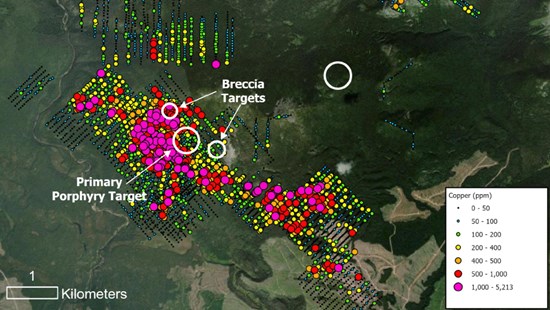
Figure 6 - A spectacular copper-in-soil anomaly defines the primary porphyry target at Trident. On a moderate slope, the source of the anomaly is most likely located near its upper extent - precisely where drilling is planned. This anomaly, combined with supporting geophysics and geology, makes Trident one of the most exciting untested porphyry copper-gold targets remaining in British Columbia.
To view an enhanced version of this graphic, please visit:
https://images.newsfilecorp.com/files/5412/264265_5770e0d7a45c5991_006full.jpg
Unlocking Untested Ground
Although nearly 80 drill holes have been completed at Trident since the 1970s, none have tested the northern porphyry and breccia targets. Historically, access to this area was prevented by the need to cross a creek, which required significant planning and permitting. With PEMC's recently granted Multi-Year Area-Based Exploration Permit, the Company is now positioned to drill this area for the very first time. This makes the 2025 program a true milestone in the project's history - opening ground that has long been considered the most prospective but remained completely untested.
Strategic Importance
The Trident drill program comes at a time when global copper demand is accelerating due to electrification, grid expansion, and electric vehicle adoption. At the same time, new large-scale copper discoveries have become increasingly rare, underscoring the importance of exploring in proven, mining-friendly jurisdictions such as British Columbia. With gold also consistently present as a by-product credit in the system, Trident has the potential to deliver the combination of size, grade, and precious metals that makes porphyry copper-gold deposits particularly attractive.
Pacific Empire believes the 2025 drill program represents the most compelling opportunity in the Trident property's 50-year history of exploration. The combination of historical mineralization at the A Zone, overlapping geophysical and geochemical anomalies at the porphyry target, and newly permitted access to never-before-drilled breccia targets creates a unique discovery opportunity. With drilling scheduled to begin in September 2025, PEMC is well positioned to advance Trident toward what could be a significant gold-enriched copper porphyry discovery.
British Columbia is home to world-class porphyry deposits, and Trident benefits from the same infrastructure advantages - road access, power, and proximity to producing mines.
Other Matters
The latest President's Newsletter, along with updated maps and Corporate Presentation, are now available at www.pemcorp.ca.
About Trident
The Trident property is a 6,618-hectare alkalic porphyry copper-gold-silver prospect located in north-central British Columbia, accessible by road. It lies approximately 50 km southeast of NorthWest Copper's Kwanika deposit and 50 km northwest of Centerra Gold's Mt. Milligan Mine. Copper mineralization was first discovered in 1969, leading to the identification of the A Zone by Falconbridge in the 1970s. Subsequent work by Kookaburra Gold (1988-1991) and Solomon Resources (2006-2008) confirmed the presence of copper-gold mineralization. In 2013, PEMC optioned the property, and in 2022 acquired a 100% interest subject to a 2% NSR, half of which can be purchased for $500,000.
A review of historical drill core by PEMC geologists has since confirmed the presence of hornblende-feldspar monzonite porphyry intrusions at the A Zone. These intrusions are typically characterized by sheeted quartz-sulphide veins with disseminated chalcopyrite and bornite, and importantly, the highest historical copper and gold grades are directly associated with these porphyry intrusions.
About Pinnacle
The Pinnacle project is located 60 km west of Centerra Gold's Mt. Milligan Copper-Gold Mine and 30 km southeast of NorthWest Copper's Kwanika Copper-Gold Deposit in a proven copper-gold porphyry district. Access to the Pinnacle is by road including a new and expanding network of logging roads and trails throughout the main target areas. This improved access is a significant development and is anticipated to contribute to cost effective drill support and provides additional bedrock exposure.
Qualified Person's Statement
Kristian Whitehead, P.Geo., serves as a qualified person as defined by NI 43-101 and has reviewed the scientific and technical information in this news release, approving the disclosure herein.
About Pacific Empire
Pacific Empire is a copper exploration company based in Vancouver, British Columbia and trades on the TSX Venture Exchange under the symbol PEMC. The Company has a district-scale land position in north-central British Columbia totaling 22,541 hectares.
British Columbia is a "Green" copper jurisdiction with abundant hydroelectric power, access and infrastructure in close proximity to the end market.
ON BEHALF OF THE BOARD,
"Brad Peters"
President, Chief Executive Officer and Director
Pacific Empire Minerals Corp.
Tel: +1-604-356-6246
brad@pemcorp.ca
www.pemcorp.ca
Neither the TSX Venture Exchange nor its Regulation Services Provider (as that term is defined in the policies of the TSX Venture Exchange) accepts responsibility for the adequacy or accuracy of this release.
Forward-Looking Statements
Information set forth in this news release may involve forward-looking statements under applicable securities laws. Forward-looking statements are statements that relate to future, not past, events. In this context, forward-looking statements often address expected future business and financial performance, and often contain words such as "anticipate", "believe", "plan", "estimate", "expect", and "intend", statements that an action or event "may", "might", "could", "should", or "will" be taken or occur, or other similar expressions. All statements, other than statements of historical fact, are forward-looking statements. By their nature, forward-looking statements involve known and unknown risks, uncertainties and other factors which may cause our actual results, performance or achievements, or other future events, to be materially different from any future results, performance or achievements expressed or implied by such forward-looking statements. Such factors include, among others, the following risks: the need for additional financing; operational risks associated with mineral exploration; fluctuations in commodity prices; title matters; environmental liability claims and insurance; reliance on key personnel; the potential for conflicts of interest among certain officers, directors or promoters with certain other projects; the absence of dividends; competition; dilution; the volatility of our common share price and volume and the additional risks identified the management discussion and analysis section of our interim and most recent annual financial statement or other reports and filings with the TSX Venture Exchange and applicable Canadian securities regulations. Forward-looking statements are made based on management's beliefs, estimates and opinions on the date that statements are made, and the Company undertakes no obligation to update forward-looking statements if these beliefs, estimates and opinions or other circumstances should change, except as required by applicable securities laws. Investors are cautioned against attributing undue certainty to forward-looking statements.

To view the source version of this press release, please visit https://www.newsfilecorp.com/release/264265
SOURCE: Pacific Empire Minerals Corp.



